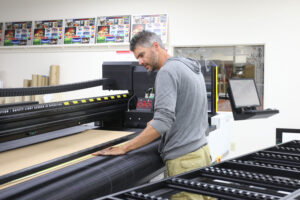It’s no secret that the exhibit industry is a complex landscape with many moving parts. To quote author Charles Pappas, the trade show world is one of the “most invisible” industries to those who are not part of it. If you’re new to the game, it can feel like an uphill battle as you learn the ins and outs. Trust us, we were all newbies once, and we empathize with you!
One of your first questions when onboarding at a company that exhibits at trade shows might be, “who puts on a trade show?” The answer isn’t simple. There are multiple parties involved, and to better understand the key players, it’s best to start with the bare bones. The trade show industry can be organized into five different groups: Exhibitors, Attendees, Organizers, Venues, General Contractors, and Designers & Builders. These five groups make up the body of a trade show. In this blog, we’ll define each key player, describe their function, and list the associations who support them.
1. The Core: Exhibitors
Exhibitors connect each part of a trade show’s anatomy together. These are the brands that will display their products and services on the show floor – that’s (probably) you!
Trade Show and Event Managers juggle planning, communicating, and coordinating their exhibit with their internal teams, an Exhibit House, General Contractors, or other Show Service Providers. These roles work with internal teams to develop their organization’s vision and goals, as well as the look and feel of their exhibit in the trade show hall. This role is dynamic, with every day bringing new demands and challenges that require a diverse set of skills.
There are many organizations for Trade Show and Event Managers to join, with some being industry-specific. CEMA (Corporate Event Marketing Association), ILEA (International Live Events Association), HCEA (Healthcare Exhibitors Association), and MPI (Meeting Professionals International) provide these roles with educational and networking opportunities across the U.S. Also, most show organizers have an event specific advisory board.
2. The Blood: Attendees
Attendees are the lifeblood of the event – these folks motivate each part of the trade show body. Attendees are those visiting a trade show with the intent of making a purchase, researching a company, attending classes to further their education or networking. Show Attendees can fall across a broad spectrum of titles and levels within organizations, and this can vary greatly from show-to-show. Ideally most attendees are buyers, decision-makers, or influencers. Unfortunately, not all will be. There are people who are involved in sales, research, design, product development, marketing, as well as executives, the media, students, and many others.
The goal is for the Exhibitors to somehow connect with the right kinds of Attendees. The Show Organizer needs to attract a specific demographic of Attendees for their show to rope in the right Exhibitors. Exhibitors need the right type of Attendee to justify the expense of exhibiting.
3. The Heart: The Organizer
The Organizer is the heartbeat of the whole trade show body. The Organizer is the company, association, or organization that is producing the show. This operation is in charge of all aspects of the show, including branding the event, planning the event, securing a venue, promoting the event, and soliciting Exhibitors.
Organizers can be broken into two categories, based on the purpose of their existence: for-profit or not-for-profit. For-profit organizers generally exist to provide a professional service of organizing trade shows across a multitude of industries, where they earn a profit from the act of successfully organizing those shows. Not-for-profit organizers generally exist to promote and support an industry association and are focused on the success of that single industry, and not primarily on generating a profit from the act of organizing the show itself. Examples of for-profit organizers would be Reed Exhibitions, E.J. Krause & Associates, Emerald Expositions, or Exhibitor Media Group. Not-for-profit examples would be the American Heart Association, United Way, or the National Council of Nonprofits.
The typical role in this category is known as either the Exposition Manager, Show Producer, or Show Manager. Broadly speaking, this role encompasses setting the “stage” for the trade show – which can be incredibly stressful! Anyone with these titles work with Vendors, Venues, and members of their organization to ensure that the objectives of the show are met, and that Exhibitors and Attendees are satisfied and want to return to the next show.
The primary goal of the Show Organizer is to attract the right “Attendees” to the show – those who are the clients & prospects of the Exhibitors. If those Attendees are not present, it all falls apart, and the Exhibitors drop out of the show. So, it is genuinely symbiotic – if the right Attendees or “Buyers” are not present, there is no benefit for the Exhibitor to attend the show. Vice versa, if the right kind of Exhibitors are not there, the Attendees are not compelled to come. Finding that balance is critical and extremely dynamic as shows change over time, and other (competing) branded shows emerge to take the spotlight.
Associations for Organizers to become members of that represent this part of the trade show body include SISO (Society of Independent Show Organizers), PCMA (Professional Convention Management Association), IAEE (International Association of Exhibitions and Events). These associations act as a voice for Organizers and provide members with educational and networking opportunities.
4. The Skeleton: The Venue
The Venue is the structure for the event, just as a skeleton is to a body. Convention centers, hotels, fairgrounds, or expo halls are all examples of venues where trade shows happen. Large venues are rented and contracted by the show organizers to provide their facility for a set number of days, which will include set-up, the actual event, and tear down.
Some of the most notable venues include the Jacob K. Javits Convention Center in New York, McCormick Place in Chicago, IL, The Las Vegas Convention Center in Las Vegas, Nevada or The Georgia World Congress Center in Atlanta, GA.
The Venue Manager is generally a primary role, and is in charge of negotiating and coordinating the trade show with The Organizer. Venues often provide electrical, rigging, security, parking and catering, among other services, and are staffed with local employees to provide them.
The most distinguished association for this group is the International Association of Venue Managers. According to their website, this organization is made up of Managers and Senior Executives across a mixture of Assembly Venues that are dedicated to educating, advocating for, and inspiring Public Assembly Venue Professionals. ESPA (Event Service Professionals Association) and IACC (International Association of Conference Centers) are additional examples.
5. The Back: General Contractors
General Contractors are one of the groups on this list doing some heavy lifting! The General Contractor is selected and contracted by the Organizer to provide services for certain aspects of the overall show on behalf of the Organizer – such as registration desks, aisle signage throughout the show hall(s), and carpet in the aisles. They are also available as the “official” Service Provider or Contractor to be hired by the Exhibitors to perform work for them. This includes services such as on-site material handling or “drayage,” labor to install & dismantle, rental items such as exhibit packages and audio-visual equipment. Two of the most prominent General Contractors are Freeman and GES.
The General Contractor, the GSC, or “Official Contractor,” is appointed by The Organizer for a specific show and can provide labor to install and dismantle exhibits for a fee. These Contractors are often unionized, depending on the state or jurisdiction of the Venue. However, if the Exhibitor does not wish to use the GSC, an Independent Labor Contractor (also known as an Exhibitor Appointed Contractor, “EAC”) can be hired by either the Exhibit House or Exhibitor to provide installation & dismantle services, provided they meet the insurance requirements to work in the particular Venue.
The most notable associations for either General or Independent Contractors include the ESCA (Exhibition Services & Contractors Association), EACA (Exhibitor Appointed Contractor Association), or IELA (International Exhibition Logistics Association). There are a variety of roles in this segment, performing an array of tasks. You may work with Audio Visual Technicians, Carpenters, Plumbers, Electricians, Porters, Decorators, or Riggers when installing or dismantling your booth.
6. The Arms: Designers & Builders
Designers & Builders are the strength of an exhibit’s build and are connected directly to the core, or the Exhibitor. This group is comprised of Exhibit Houses that partner with Exhibitors to develop the trade show experience, including the design and production of the Exhibitor’s booth. They’re the direct line of contact and work with the Exhibitor, and often other independent contractors to bring an exhibit to life. Several notable Exhibit Houses include 2020 Exhibits, Freeman, Access TCA, 3D Exhibits, and the authors of this very blog, Exhibit Concepts.
Like all the parts we’ve discussed to this point, you’ll interact with different roles at these companies. Usually, the main point of contact is the Account Executive, who is primarily responsible for maintaining the relationship with the Exhibitor. Additionally, there are Graphic Designers, Exhibit Designers, Engagement Strategists, Project Managers, Account Managers, Fabricators, Carpenters, and A/V Specialists, to name a few.
The most notable association in this category that supports, educates, and advocates for members in the event industry dedicated to designing, producing, and building of exhibits is the EDPA (Experiential Designers and Producers Association).
The trade show industry is complicated, and it takes a variety of players to make it all work. Each aspect has issues, and intricacies that can’t be packed into a single blog post. But understanding the basics of these five groups will help you grasp the operations of a trade show as you move down the line.
If you’re brand new to the industry, welcome and hang in there! It’s challenging but rewarding to experience. And hey, if you don’t nail this concept completely, we all know at least one universal truth: mitochondria are the powerhouse of the cell.











